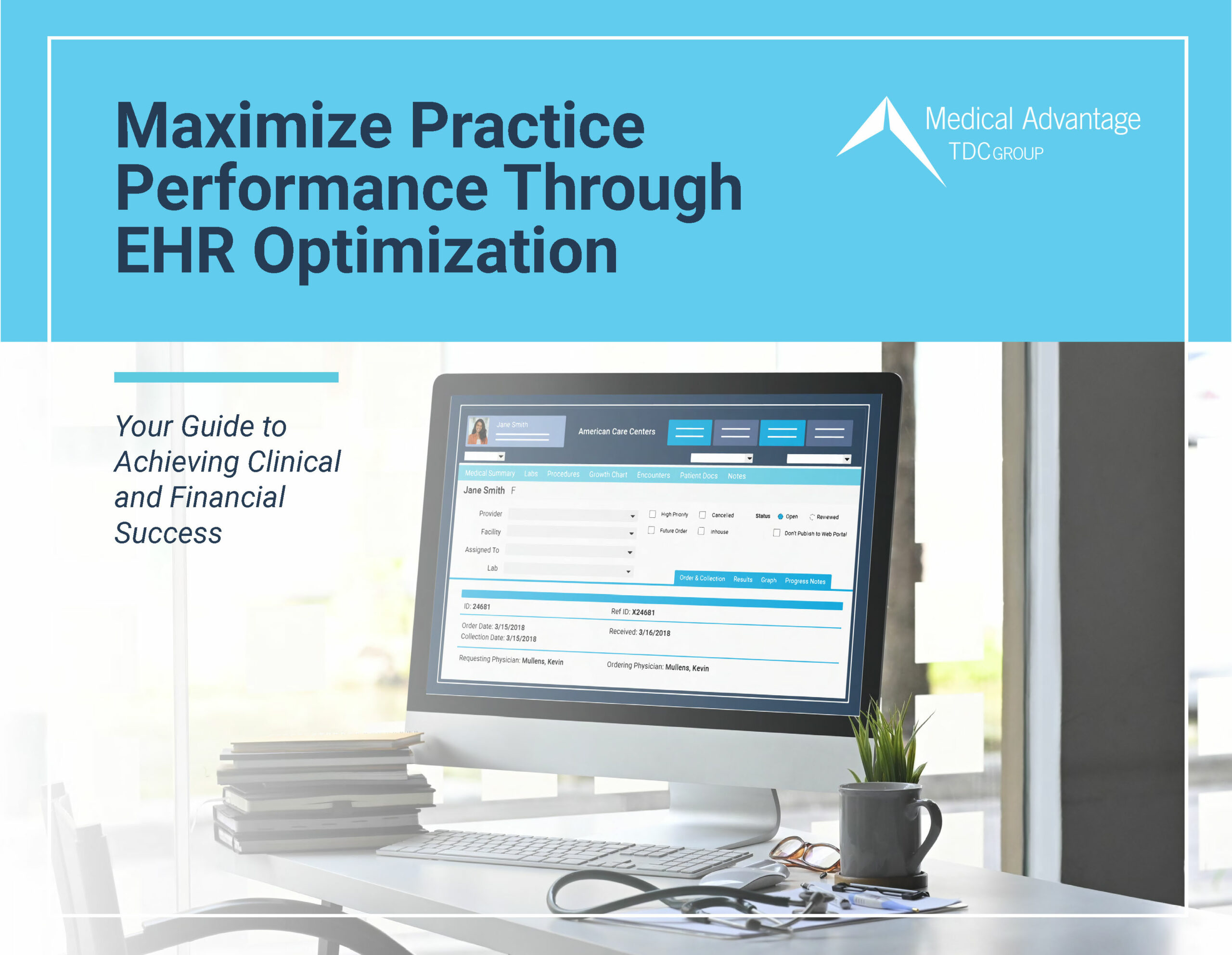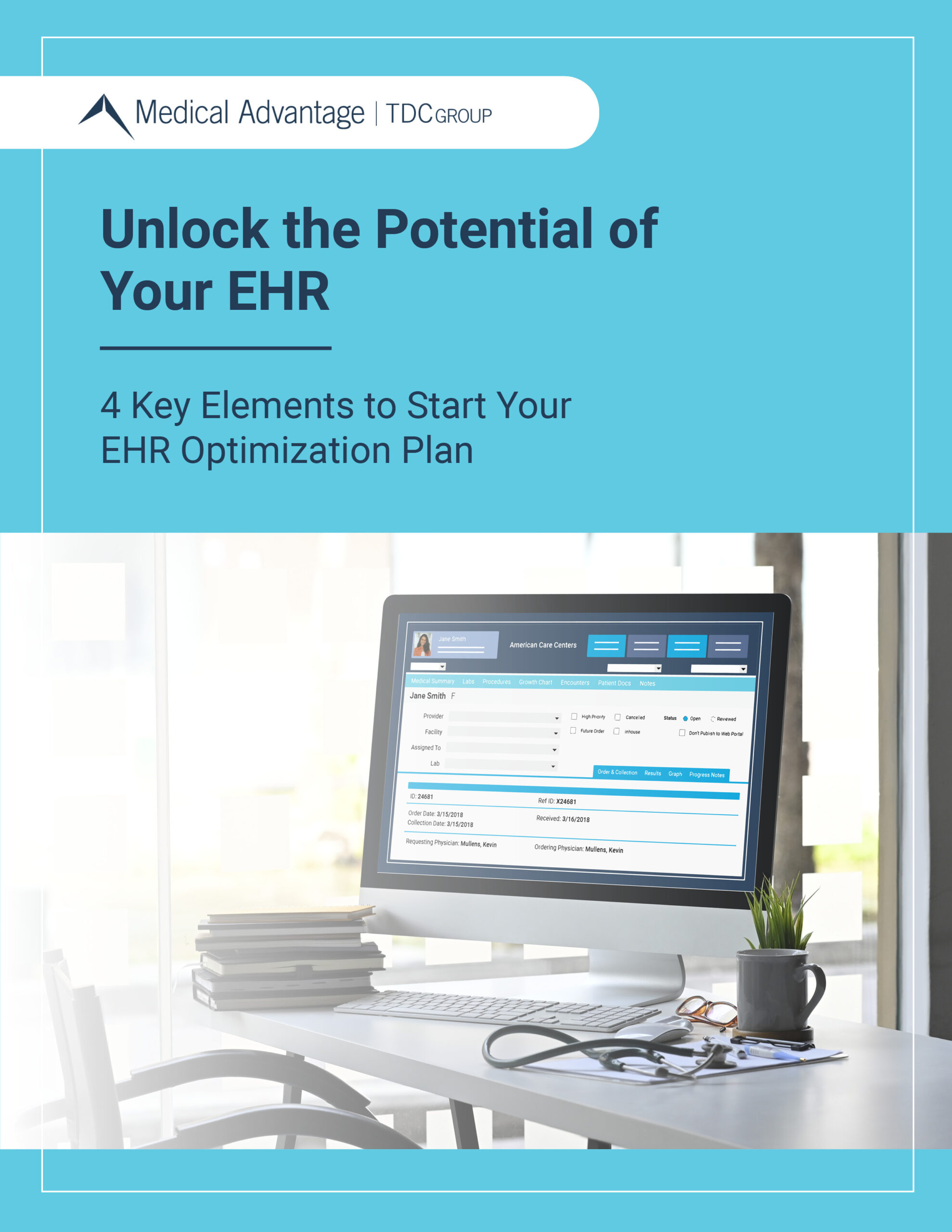EHR Consulting
Unlock the Power of the EHR to Transform Operations from A to Z
Start your transformation journey by bringing your EHR into alignment with what your medical practices needs to be successful. Backed by years of experience working with a variety of software brands, our personalized EHR consulting solutions streamline workflows for better financial performance, increased staff satisfaction, and improved care quality.

Shaping Up Your EHR Begins with a Diagnosis. Is Your Organization Experiencing Any of These Symptoms?
Decreased Revenue
Without an EHR workflow tailored to your healthcare organization, claims and other data will not move efficiently through the revenue cycle system.
Low Productivity
Your EHR is the heart of practice and clinical operations – when it is not optimized, productivity can suffer.
Lack of Interoperability
When your EHR applications and system are not properly set up, this hinders standardization and interoperability.
Worsened Performance
Without an optimized EHR workflow, claims and other data will not move efficiently through the system and may lead to costly staff augmentation.
Decreased Quality Scores
If doctors do not have an accurate medical history of a patient, they may prescribe the wrong medication or make other errors, leading to complications and decreased quality scores.
Revitalize Your Organization by Investing in Your EHR
Imagine an EHR built with your success in mind. Have a look at what EHR consulting has in store for your operations:
More Time for Patients
An enhanced EHR better tailored to workflows improves care quality by reducing the need for frustrating documentation and allowing more time to improve patient care.
Improved Reimbursement
Happier Staff
A blend of training, system customization, and data integration – as well as our EHR consultants working alongside your team – all work to reduce staff and leadership burnout.
On-Demand Support
Our EHR consultant team is not successful until your team is successful. With on-demand live support from our EHR Helpdesk, timely response to your trouble tickets means you are never on your own.
EHR Consultants with Decades of Healthcare Experience
With over two decades working in the healthcare space, our EHR consulting company has made improvements in patient care quality, administrative efficiency, and profitability and ensured compliance for thousands of organizations and we will do the same for you.
What makes the Medical Advantage team different from other healthcare IT consultants? Our EMR experts hail from a variety of backgrounds, both in the IT and healthcare space. Before holding consultant positions, many on our team worked in the care-delivery world themselves, and once stood in the shoes of the people they now work to support. Our EHR consulting comes with a deep understanding of EHR systems and the latest in training to tailor your EHR for peak system performance.
Reduced
38%
of overdue alerts
Over
22%
increase in patient portal engagement
Reduced
74%
of lab results open for 7+ days
Over
10%
increase in patient visits
WHAT OUR CUSTOMERS ARE SAYING
Start Getting More out of Your EHR Investment Today
Read Our EHR Optimization eBook
Get a sneak preview into our guide for optimizing your EHR. In these pages is everything you need to create an optimization plan and improve your practice operations.
EHR Consulting Services
EHR Optimization
EHR Migration
Go-Live Support
EHR Helpdesk
Our EHR Helpdesk offers on-demand Q&A support, along with “how-to” advice for simple EHR requests.
EHR Training and Support
Telehealth Consulting
Our telehealth consultants help ensure your Telehealth system is integrated properly with your EHR, and providing convenient care to patients.
Flexible Timing
Flexible Engagements
Working With Your Practice’s EHR System
What EHR software does Medical Advantage work with? All of them. Whatever system you currently have or are considering, chances are high that our EMR experts have ample experience with that name brand. Our EHR consulting company is EHR agnostic, meaning we adapt our suite of solutions to any system to make it more efficient and effective for overall operations.
eClinicalWorks
The innovative eClinicalWorks EHR is known for its interoperability, facilitating seamless data exchange and integration with other healthcare systems and platforms.
NextGen
The intuitive NextGen EHR—known for its versatility and customization options—offers features such as clinical decision support tools, population health management capabilities, and revenue cycle management functionalities.
Allscripts
The flexible and adaptable AllScripts EHR is esteemed for its ability to streamline clinical workflows, improve patient outcomes, and support population health management initiatives.
athenaHealth
Cloud-based athenaHealth is known for its interoperability, enabling seamless data exchange with other systems and healthcare partners and also offers RCM functionalities designed to maximize reimbursement and improve financial performance.

Epic
The classic Epic —a leading EHR in the health care industry—is widely used by hospitals, healthcare systems, and medical practices to manage patient records. Its robust data analytics capabilities generate insights for quality improvement and population health management.
Proven Success Through Hands-On Support
Our consultants are experienced healthcare professionals with a track record of delivering clients results. Read for yourself.
Start Getting More out of Your EHR Investment Today
Explore Related EHR Resources
Frequently Asked Questions About Our EHR Consulting Services
What Is Electronic Health Records (EHR) or Electronic Medical Records (EMR) Consulting?
Electronic health records (EHR) or electronic medical records (EMR) consultants work with healthcare organizations to optimize their existing or new electronic health record systems. These EMR experts help physicians and other healthcare personnel learn how to fully leverage the system’s functionality and ensure accuracy. EHR consulting also involves troubleshooting problems and recommending measures that promote compliance.
What Do Electronic Health Records (EHR) or Electronic Medical Records (EMR) Consultants Do?
EHR and EMR consultants are highly skilled professionals with extensive expertise in both healthcare and technology. They work closely with healthcare providers to understand their specific needs and goals, and then provide tailored solutions to help them meet their objectives.
Implementing EHR Systems
One of the main roles of EMR experts is to help healthcare systems successfully implement new EHR systems. EMR or EHR implementation involves designing and customizing the system to meet the organization’s unique requirements, as well as migrating data from existing systems.
Training and Support
EMR or EHR consultants also play a vital role in training healthcare personnel on how to effectively use the EHR system. This includes educating them on the system’s functionalities and best practices for data entry to ensure accurate and consistent documentation. They can also provide personalized training for each medical team staff member based on their individual job description.
Ensuring Compliance
EHR systems are subject to strict regulatory standards, such as the Health Insurance Portability and Accountability Act (HIPAA). EHR consultants help healthcare organizations ensure that their system complies with these regulations to protect patient privacy and security.
Benefits of Working with Electronic Health Records (EHR) or Electronic Medical Records (EMR) Consultants
Partnering with an electronic health records (EHR) or electronic medical record (EMR) consultant offers numerous benefits for health systems, including:
- Expertise and experience: EHR or EMR consultants bring in-depth knowledge and experience in both healthcare and technology, making them valuable assets in implementing and optimizing EHR systems. With high stakes projects such as data migration during a move to a new EHR, consulting services can help organizations avoid costly mistakes.
- Cost savings: Rather than hiring a full-time IT team to manage EHR systems, organizations can cut costs by working with external consultants who provide specialized services.
- Increased efficiency: By optimizing EHR systems, consultants help healthcare organizations improve their workflow and streamline processes, leading to increased efficiency and productivity, contributing to a better patient experience.
- Compliance and security: EMR or EHR consultants are well-versed in regulatory standards and can ensure that the system meets all compliance requirements, reducing the risk of penalties or breaches.
What Do EHR Consulting Companies Do?
The EHR consulting company dispatches an EHR or EMR consultant to carry out project management for clients. Lending their technical expertise, consultants digitalize medical practices, simplify EHR workflows, and reduce clicks to make tasks more efficient and less error prone. EHR consultants also help providers improve patient outcomes, reduce overhead costs, and increase staff satisfaction and retention with comprehensive operational consultation.
How Can I Improve My EHR System?
Customization based on staff feedback to streamline workflows, reduce clicks, and eliminate redundancies can make a significant difference in operational efficiency and user satisfaction. An experienced EHR consultant can help you identify issues, ascertain your requirements, and offer tailor-made workflows and customizations, such as documentation tools, personalized templates, order sets, and macros. They also can provide user training for optimal performance.
What Are the Main Goals of EMR User Training?
The main goal of EMR user training is to equip medical staff to use the EMR system more effectively. Additional objectives include:
- Understanding the technology: This is the most important aspect of the training. EHR users benefit most from understanding how to navigate the software and the technological tools in use.
- Following best practices and workflows: EMR training provides staff with a clear understanding of workflows to follow when documenting care.
- Improving patient outcomes: A well-trained staff that can accurately document care, medications, and clinical information can improve patient outcomes.















